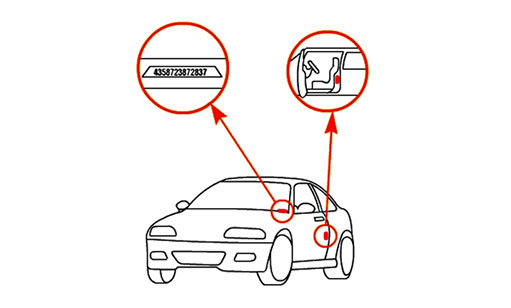Get a free VIN check
Every vehicle you can see on the road has its own, unique Vehicle Identification Number (VIN). It is also sometimes referred to as the body number. VIN is unique to every vehicle, which literally means that no two cars share the same VIN. This is why the number is often compared to a car's DNA or a fingerprint, as it makes it possible to identify a vehicle just as easily and precisely.
What is VIN number
VIN is not only used to identify passenger cars but also all the other vehicle types, from motorcycles and mopeds, through buses, trucks, and even trailers.

What data does the VIN include?
The first three units are the WMI; it is the identification code of the manufacturer and country where the car was assembled. For instance, cars with their VINs beginning with “J” are all made in Japan, while those whose VIN begins with “1” are made in the USA.
The second part of VIN includes vehicle type information. Every manufacturer codes this info in their own way but it is always included in units 4 to 9. It is here that you can identify whether the car has air bags, what safety belts are fitted in it, what body type it has and how many doors, as well as what class of car it is (e.g. SUV, economy class). The last unit in this section is the VIN control digit: a special algorithm makes it possible to verify that none of the previous characters has been illegally modified.
Units 10 to 17 are letters and digits (the last 4 are always digits) that not only make it possible to identify the exact car (this part is unique for every vehicle), but they also contain data regarding the engine version, drive type, accessories and the like. It is also here that information on the model year and factory where the car was manufactured can be found (the year is always placed at unit 10).
Where to find the VIN?

Vehicle Title
The place you should start looking for the VIN number from is the “E” field of the vehicle’s registration book. This is a required field; it must be filled in so the vehicle can be registered. This means it should never be empty. It is good to know that the VIN number provided in the book should be the same as the VIN on the nameplate you can find in the car.

Windshield
Most of contemporary vehicles have the VIN number in the lower part of the windscreen, on the driver side. The 17 digits should be easily accessible so you won’t need the seller to assist you in finding the VIN.

Body elements
Some vehicles will have the VIN on different elements of the body. It may be found in the bottom part of the pillar, next to the front passenger seat (Skoda, Seat). You may also be able to find it next to front door hinges (Audi), or on the firewall (BMW, Volvo).
A 12-character VIN number
In some cases, the VIN you will find in the car will only contain 12 characters. The number may be shorter because the previous one was damaged or unreadable and the owner decided to replace it in accordance with applicable regulations.
It is also worth noting that the VIN you can find in antique cars may be different than the current 17-character VIN number. There was no standard for the VIN numbers between 1954 and 1981 so different manufacturers used different formats.